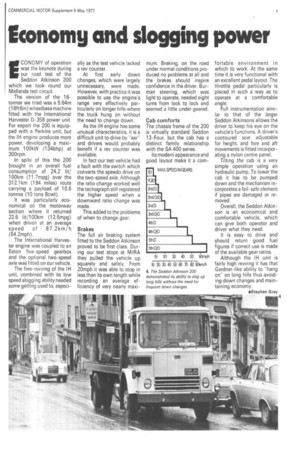Economy and slogging power
Page 53

If you've noticed an error in this article please click here to report it so we can fix it.
ECONOMY of operation was the keynote during our road test of the Seddon Atkinson 200 which we took round our Midlands test circuit.
The version of the 16tonner we tried was a 5.64m (18ft 6in) wheelbase machine fitted with the International Harvester D-358 power unit. For export the 200 is equipped with a Perkins unit, but the IH engine produces more power, developing a maximum 100kW (134bhp) at 30Orpm.
In spite of this the 200 brought in an overall fuel consumption of 24.2 lit/ 100km (11.7mpg) over the 312.1km (194 miles) route carrying a payload of 10.6 tonnes (10 tons 8cwt).
It was particularly economical on the motorway section where it returned 22.6 lit/100km (12.5mpg) when driven at an average speed of 87.2km/h (54.2mph).
The International Harvester engine was coupled to an Eaton five-speed gearbox and the optional two-speed axle was fitted on our vehicle.
The free-revving of the IH unit, combined with its low speed slogging ability needed some getting used to, especi
ally as the test vehicle lacked a rev counter.
At first early down changes, which were largely unnecessary, were made. However, with practice it was possible to use the engine's range very effectively particularly on longer hills where the truck hung on without the need to change down.
As the IH engine has some unusual characteristics, it is a difficult unit to drive by "ear" and drivers would probably benefit if a rev counter was available.
In fact our test vehicle had a fault with the switch which converts the speedo drive on the two-speed axle. Although the ratio change worked well the tachograph still registered the higher speed when a downward ratio change was made.
This added to the problems of when to change gear.
Brakes The full air braking system fitted to the Seddon Atkinson proved to be first class. During our test stops at MIRA they pulled the vehicle up squarely and safely. From 20mph it was able to stop in less than its own length while recording an average efficiency of very nearly maxi mum. Braking, on the road under normal conditions produced no problems at all and the brakes should inspire confidence in the driver. Burman steering, which was light to operate, needed eight turns from lock to lock and seemed a little under geared.
Cab comforts The chassis frame of the 200 is virtually standard Seddon 13-Four, but the cab has a distinct family relationship with the SA 400 series.
Its modern appearance and good layout make it a corn
4. The Seddon Atkinson 200 demonstrated its ability to slog up long hills without the need for frequent down changes.
fortable environment in which to work. At the same time it is very functional with an excellent pedal layout. The throttle pedal particularly is placed in such a way as to operate at a comfortable angle.
Full instrumentation similar to that of the larger Seddon Atkinsons allows the driver to keep his eye on the vehicle's functions. A driver's contoured seat adjustable for height, and fore and aft movements is fitted incorporating a nylon centre panel.
Tilting the cab is a very simple operation using an hydraulic pump. To lower the cab it has to be pumped down and the mechanism incorporates a fail-safe element if pipes are damaged or removed.
Overall, the Seddon Atkinson is an economical and comfortable vehicle, which can give both operator and driver what they need.
It is easy to drive and should return good fuel figures if correct use is made of the available gear ratios.
Although the IN unit is fairly high revving it has that Gardner-like ability to "hang on" on long hills thus avoiding down changes and maintaining economy.
























































































































